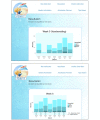Translating Promoting Factors and Behavior Change Principles Into a Blended and Technology-Supported Intervention to Stimulate Physical Activity in Children With Asthma (Foxfit): Design Study
- PMID: 35877162
- PMCID: PMC9361148
- DOI: 10.2196/34121
Translating Promoting Factors and Behavior Change Principles Into a Blended and Technology-Supported Intervention to Stimulate Physical Activity in Children With Asthma (Foxfit): Design Study
Abstract
Background: Children with asthma can decrease the impact of their disease by improving their physical activity (PA). However, health care providers lack interventions for children with asthma that effectively increase their PA levels and achieve behavior change. A technology-supported approach can positively influence PA and physical functioning in children.
Objective: The aims of this study were to develop a technology-supported intervention that facilitates health care providers in promoting PA for children (aged 8 to 12 years) with asthma and to systematically describe this developmental process.
Methods: Intervention mapping (IM) was applied to develop a blended and technology-supported intervention in cocreation with children with asthma, their parents, and health care providers. In accordance with the IM framework, the following steps were performed: conduct a needs assessment; define the intervention outcome, performance objectives, and change objectives; select theory-based intervention methods and strategies; create components of the intervention and conduct pilot tests; create an implementation plan; and create an evaluation plan.
Results: We developed the blended intervention Foxfit that consists of an app with a PA monitor for children (aged 8 to 12 years) with asthma and a web-based dashboard for their health care provider. The intervention focuses on PA in everyday life to improve social participation. Foxfit contains components based on behavior change principles and gamification, including goal setting, rewards, action planning, monitoring, shaping knowledge, a gamified story, personal coaching and feedback, and a tailored approach. An evaluation plan was created to assess the intervention's usability and feasibility for both children and health care providers.
Conclusions: The IM framework was very useful for systematically developing a technology-supported intervention and for describing the translational process from scientific evidence, the needs and wishes of future users, and behavior change principles into this intervention. This has led to the technology-supported intervention Foxfit that facilitates health care providers in promoting PA in children with asthma. The structured description of the development process and functional components shows the way behavior change techniques are incorporated in the intervention.
Trial registration: International Clinical Trial Registry Platform NTR6658; https://tinyurl.com/3rxejksf.
Keywords: chronic disease; cocreation; exercise; gamification; intervention mapping; mHealth; mobile app; mobile health; mobile phone; social participation; tailoring; technology-supported intervention; web-based dashboard.
©Annette Brons, Katja Braam, Aline Broekema, Annieck Timmerman, Karel Millenaar, Raoul Engelbert, Ben Kröse, Bart Visser. Originally published in JMIR Formative Research (https://formative.jmir.org), 25.07.2022.
Conflict of interest statement
Conflicts of Interest: None declared.
Figures








References
-
- Riner WF, Sellhorst SH. Physical activity and exercise in children with chronic health conditions. J Sport Health Sci. 2013 Mar;2(1):12–20. doi: 10.1016/j.jshs.2012.11.005. - DOI
-
- Fact Sheet Asthma. World Health Organization. [2021-09-14]. https://www.who.int/news-room/fact-sheets/detail/asthma .
LinkOut - more resources
Full Text Sources

